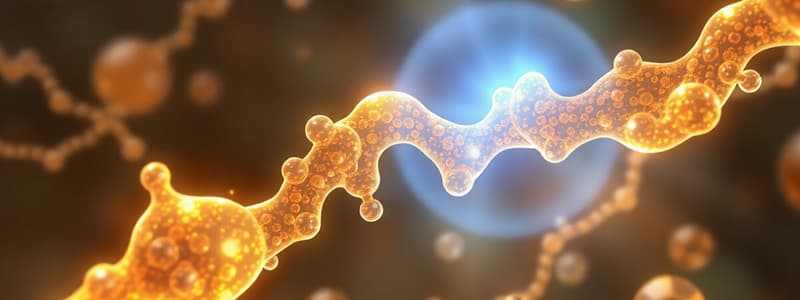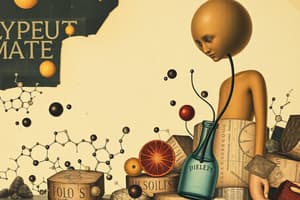Podcast
Questions and Answers
What is the primary function of bile salts in lipid digestion?
What is the primary function of bile salts in lipid digestion?
- To form micelles for absorption
- To transport lipids through the bloodstream
- To convert triacylglycerols into fatty acids
- To render lipid droplets more accessible to digestion (correct)
What are chylomicrons primarily responsible for transporting?
What are chylomicrons primarily responsible for transporting?
- Fatty acids from blood to liver
- Lipids from liver to muscle tissue
- Reformed triacylglycerols from the intestine (correct)
- Cholesterol from tissues to the liver
Which of the following correctly describes lipoproteins?
Which of the following correctly describes lipoproteins?
- They are solely composed of lipids.
- They are produced exclusively in the intestine.
- They consist of specific carrier proteins and different combinations of lipids. (correct)
- They only transport cholesterol in the bloodstream.
How are triglycerides further removed from VLDL to form LDL?
How are triglycerides further removed from VLDL to form LDL?
What is the role of apoproteins in lipoproteins?
What is the role of apoproteins in lipoproteins?
What defines the common feature of lipids?
What defines the common feature of lipids?
Which type of fatty acid contains one or more double bonds?
Which type of fatty acid contains one or more double bonds?
What type of lipid is primarily a stored energy form in adipose tissue?
What type of lipid is primarily a stored energy form in adipose tissue?
What is a significant role of sterols, like cholesterol, in the body?
What is a significant role of sterols, like cholesterol, in the body?
Which classification of lipids cannot be divided into simpler structural units?
Which classification of lipids cannot be divided into simpler structural units?
What is the primary function of bile acids in digestion?
What is the primary function of bile acids in digestion?
What characterizes simple acylglycerides?
What characterizes simple acylglycerides?
Which of the following is a characteristic of fatty acids?
Which of the following is a characteristic of fatty acids?
What is the role of L-carnitine in fatty acid metabolism?
What is the role of L-carnitine in fatty acid metabolism?
What triggers the mobilization of triacylglycerols from adipose tissue?
What triggers the mobilization of triacylglycerols from adipose tissue?
What is the main process through which triacylglycerols are converted into energy?
What is the main process through which triacylglycerols are converted into energy?
How does the energy from fatty acids ultimately enter the citric acid cycle?
How does the energy from fatty acids ultimately enter the citric acid cycle?
In lipid removal, what is the first step in the degradation process?
In lipid removal, what is the first step in the degradation process?
What happens to fatty acids during β-oxidation?
What happens to fatty acids during β-oxidation?
What is the final product of fatty acid degradation that enters the citric acid cycle?
What is the final product of fatty acid degradation that enters the citric acid cycle?
Which hormone primarily stimulates the release of fatty acids from adipose tissue during fasting?
Which hormone primarily stimulates the release of fatty acids from adipose tissue during fasting?
Flashcards
Role of Bile Salts in Fat Digestion
Role of Bile Salts in Fat Digestion
Bile salts, secreted from the gallbladder, aid in fat digestion by emulsifying lipid droplets, making them more accessible to lipases.
Action of Lipases
Action of Lipases
Lipases, enzymes secreted by the pancreas, break down triacylglycerols into two fatty acids and a monoacylglycerol.
Micelle Transport
Micelle Transport
Micelles, small lipid droplets surrounded by bile salts, transport digestion products of lipids to intestinal epithelial cells for absorption.
Chylomicron Formation
Chylomicron Formation
Signup and view all the flashcards
Chylomicron Transport in Blood
Chylomicron Transport in Blood
Signup and view all the flashcards
Lipolysis
Lipolysis
Signup and view all the flashcards
Epinephrine
Epinephrine
Signup and view all the flashcards
Glucagon
Glucagon
Signup and view all the flashcards
Hormone-sensitive lipase (HSL)
Hormone-sensitive lipase (HSL)
Signup and view all the flashcards
Fatty acid activation
Fatty acid activation
Signup and view all the flashcards
L-carnitine
L-carnitine
Signup and view all the flashcards
Beta-oxidation
Beta-oxidation
Signup and view all the flashcards
Acetyl-CoA
Acetyl-CoA
Signup and view all the flashcards
What are Lipids?
What are Lipids?
Signup and view all the flashcards
What are Fatty Acids?
What are Fatty Acids?
Signup and view all the flashcards
How are fatty acids classified?
How are fatty acids classified?
Signup and view all the flashcards
What are Acylglycerides?
What are Acylglycerides?
Signup and view all the flashcards
What is Cholesterol?
What is Cholesterol?
Signup and view all the flashcards
What is the first step of lipid digestion?
What is the first step of lipid digestion?
Signup and view all the flashcards
How are lipids absorbed?
How are lipids absorbed?
Signup and view all the flashcards
What are Chylomicrons?
What are Chylomicrons?
Signup and view all the flashcards
Study Notes
Lipid Metabolism
- Lipids are a diverse group of compounds sharing the common characteristic of insolubility in water.
- Lipids are hydrophobic.
- Biological functions of lipids include storage of energy, structural elements of biological membranes, hormones, intra- and extracellular signaling, and protection of internal organs.
- Key forms of lipids include fatty acids, glycerol, triglycerides, phospholipids, sterols, vitamins (A, E, D, K).
- Fatty acids range from 4 to 36 carbons in length.
- Saturated fatty acids have no double bonds while unsaturated fatty acids have one or more double bonds.
- Classification of lipids is based on their structure (simple vs complex).
- Simple lipids cannot be divided into simpler units while complex lipids can be divided into simpler structural units. Examples of simple lipids include fatty acids, terpenes, sterols, eicosanoids. Examples of complex lipids are acylglycerides, phosphoacylglycerides, sphingolipids, waxes.
- Acylglycerides are composed of 1, 2, 3 fatty acids linked to a glycerol molecule. Types of acylglycerides include monoacylglycerides, diacylglycerides, and triacylglycerides.
- Triacylglycerols are the primary stored form of energy in adipose tissue.
- Sterols, like cholesterol, are structural lipids in cell membranes and precursors for steroid hormones.
- Cholesterol is amphipathic, having a polar head group (-OH) and a nonpolar hydrocarbon body.
- Cholesterol is a precursor to steroid hormones like estrogens, testosterone, progesterone, and cortisol as well as bile acids which emulsify dietary fats.
- Cholesterol is also important for vitamin D synthesis and plays a role in the transport of lipids in the blood.
Digestion and Absorption of Lipids
- Dietary lipids (triacylglycerols) form droplets in the stomach.
- Bile salts secreted from the gallbladder emulsify lipids.
- Lipases secreted from the pancreas convert triacylglycerols into fatty acids and monoacylglycerols.
- Digestion products are carried as micelles to the intestinal epithelium cells.
- Triacylglycerols are reformed from the free fatty acids and monoacylglycerol.
- Lipoproteins (chylomicrons) are formed and transport triacylglycerols to tissues.
Transport of Lipids in the Blood
- Lipoproteins are macromolecular complexes of specific carrier proteins and various combinations of lipids.
- Proteins solubilize lipids and direct them to specific targets.
- Lipoprotein types include chylomicrons, very low-density lipoproteins (VLDL), low-density lipoproteins (LDL) and high-density lipoproteins (HDL).
- Chylomicrons transport dietary lipids from the intestines to the liver.
- VLDL transports triglycerides synthesized in the liver to other tissues.
- LDL carries cholesterol from the liver to other tissues.
- HDL reverse cholesterol transport. They pick up cholesterol from extrahepatic tissues and return it to the liver.
Lipid Storage
- Triacylglycerols are stored in adipocytes (fat cells) in lipid droplets when more fatty acids are consumed than needed.
- When energy is needed, triacylglycerols in adipose tissue are broken down and transported to tissues needing energy.
Lipid Removal
- Fatty acids stored in adipose tissue are converted into energy in three stages.
- Stage 1: Mobilization of triacylglycerols in adipose tissue, stimulated by hormones like epinephrine (fight or flight) and glucagon (fasting). Hormone-sensitive lipase (HSL) hydrolyzes triacylglycerols into fatty acids and glycerol which then enter the bloodstream.
- Stage 2: Activation of fatty acids and transport into the mitochondria. The fatty acids are activated to fatty acyl-CoAs and transported into the mitochondria via the carnitine shuttle.
- Stage 3: Degradation of fatty acids to acetyl-CoA, which is processed by the citric acid cycle for energy production.
Fatty Acid Synthesis
- Fatty acids are synthesized from acetyl-CoA derived from glucose or amino acids.
- The location of synthesis is the cytosol, primarily within the liver.
- The enzyme involved is fatty acid synthase.
- Fatty acid synthesis involves growing the fatty acid chain in two-carbon increments.
Overall Regulation of Lipid Metabolism
- Regulation of lipid metabolism varies depending on fasting/exercise and after a meal/resting state.
- During fasting/exercise, hormones like glucagon and epinephrine stimulate lipolysis and beta-oxidation.
- After a meal and resting periods, insulin stimulates fatty acid synthesis.
- Carbohydrate-rich diets can also promote fatty acid synthesis.
Studying That Suits You
Use AI to generate personalized quizzes and flashcards to suit your learning preferences.




